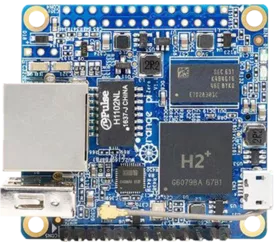Orange Pi Zero Plus vs Raspberry Pi Zero 2 W
SOURCE ARTICLES
Orange Pi 5 Plus Review
bret.dk
The Orange Pi 5 Plus is a Rockchip RK3588-based Single Board Computer with 2 2.5Gbit RJ45 Ethernet ports and a full-size HDMI port. It suffers from software issues due to old kernels and lacks mainline support. It has various operating systems available, including Armbian, Ubuntu, and Windows. The board performs well in compute, crypto, and network benchmarks. It supports NVMe and eMMC storage options. The I/O placement is convenient, and the default APT repository has improved. However, the software support remains a drawback. Overall, the Orange Pi 5 Plus offers good hardware but is held back by software limitations.
Quick review of Orange Pi One
forum.armbian.com
The Orange Pi One is a smaller and cheaper version of the Orange Pi PC. It has a smaller size, less RAM, and fewer USB ports. It also lacks an IR receiver, microphone, and TRRS jack. The GPIO header is rotated by 180 degrees. The One costs $10 compared to the PC's $15. However, the smaller size means that add-on boards project over the board. The One uses a different method to regulate the SoC's core voltage, which has caused some issues. It is necessary to make fixes when using OS images for the PC on the One. The software support for the One is improving, with Armbian and OpenELEC providing support. Mainlining efforts for the H3 are also progressing. Enclosures are available for the One, but it suffers from heat issues.
The Orange Pi Zero 3
taoofmac.com
The Orange Pi Zero 3 is a single-board computer with 4GB of RAM, a Gigabit Ethernet port, and USB-C for power. It runs on the AllWinner H618 SoC with quad-core ARM Cortex-A53 cores. The board has a micro-HDMI port, an SD card slot for storage, and a 26-pin GPIO header. It also has an optional expansion board with additional USB-A ports, a 3.5mm audio jack, a microphone, and an IR receiver. The software support for the board is complicated, with no official support from Armbian and limited options for customizing or building Linux images. The board performs well as a thin client and can be used for running Klipper/Octoprint alongside a 3D printer. It can also be used as a home router with features like Pi-hole for ad blocking or OpenWRT for a personal VPN. The only hardware flaw is the lack of EMMC storage.
Orange Pi Zero 2 – Review / Benchmark / Tips – ~$35 Price
The Orange Pi Zero 2 is a low-cost single board computer (SBC) that comes with 512 MB or 1 GB RAM options. It includes built-in WiFi with an external antenna and comes with a case and a short USB-C power cable. The board is widely available and can be compared to the Raspberry Pi. The review suggests using the newest image/kernel for better performance and recommends using a heatsink kit to prevent overheating. The imaging process is straightforward, and the performance benchmark showed a score of 1,081, about 15% lower than the Raspberry Pi 4. The Orange Pi Zero 2 is considered a good option for projects like a Pi Hole or low-powered servers/services. It is not as good as the Raspberry Pi but is rated highly among other manufacturers.
Review: Orange Pi Zero
The Orange Pi Zero is a cheap alternative to the Raspberry Pi, offering similar features with a few advantages. It is a good choice for always-on LAN server projects, thanks to its Ethernet port and reliable wired networking. The slightly faster CPU and standard USB port are also beneficial. However, if Bluetooth or micro HDMI is needed, the Raspberry Pi is a better option. The Orange Pi may require some additional setup and documentation is not as extensive as the Raspberry Pi. Overall, considering its price of $11.49, the Orange Pi Zero is worth considering for certain projects.
Review: Raspberry Pi Zero 2W — HackSpace magazine
The Raspberry Pi Zero 2 W is a pin-compatible replacement for the original Zero, offering a significant boost in processor performance. It features a BCM2710 silicon die with four cores running at 1GHz, resulting in a 40% increase in single-core performance. The board retains the same features as the original Zero, making it compatible with existing projects. The software upgrade is seamless, and other operating systems should also work. The increased speed and processing power make it ideal for machine learning, handheld gaming, and tasks like hosting a web interface and controlling hardware. Overall, the Zero 2 W is a highly recommended upgrade, offering a big speed increase in a tiny package.
+ 3
AI COMPARISON
Comparison Table
| Feature | Orange Pi Zero Plus | Raspberry Pi Zero 2 W |
|---|---|---|
| USB Ports | 3 | 1 |
| Volume | 28.08 cm³ | 25.35 cm³ |
| Dimensions (mm) | 48 x 45 x 13 | 30 x 65 x 13 |
| Weight | 26 g | 8.9 g |
| RAM | 0.5 GB | 0.5 GB |
| External Memory Slot | Yes | Yes |
| Max Expandable Memory | 32 GB | N/A |
| Internal Storage | 0.2 GB | N/A |
| 64-bit Support | Yes | Yes |
| Integrated Graphics | Yes | Yes |
| OpenGL ES Version | 2.2 | 2 |
| Semiconductor Size | 28 nm | N/A |
| Total Clock Speed | 4.8 GHz | 4 GHz |
| HDMI | No | Yes |
| WLAN | Yes (WiFi 4) | Yes (WiFi 4) |
| Bluetooth | No | Yes (4.2) |
| Ethernet | Yes | No |
| USB Version | 2 | 2 |
| Microphone In | Yes | No |
Summary
Both the Orange Pi Zero Plus and Raspberry Pi Zero 2 W offer similar RAM and WiFi capabilities, but there are key differences in their feature sets. The Orange Pi Zero Plus includes three USB ports and an Ethernet port, making it suitable for always-on LAN server projects, while the Raspberry Pi Zero 2 W only has one USB port but includes Bluetooth 4.2 support and HDMI, enhancing its suitability for media projects and desktop usage.
The Raspberry Pi Zero 2 W is smaller in volume and weight, making it more portable, but lacks an Ethernet port, which is available on the Orange Pi Zero Plus. Both support 64-bit processing and integrated graphics, but the Orange Pi Zero Plus boasts a higher total clock speed at 4.8 GHz compared to the 4 GHz of the Raspberry Pi Zero 2 W.
Recommendations
For users requiring a compact SBC with HDMI output and Bluetooth for media projects or lightweight desktop applications, the Raspberry Pi Zero 2 W is recommended. Its enhanced processor and perfect score in performance reviews make it ideal for embedded projects and educational purposes.
Conversely, the Orange Pi Zero Plus is better suited for server-based applications due to its multiple USB ports and Ethernet connectivity. Its slightly larger size and weight are trade-offs for its added connectivity features, making it ideal for users who need a reliable, always-on network server or a project base that doesn't require HDMI or Bluetooth.
PRICES
ASK AI
BestVs.ai
Hello, I'm your AI shopping assistant. How can I help you?
AI can make mistakes. Consider checking important information.


